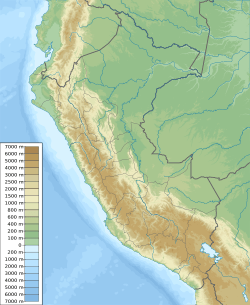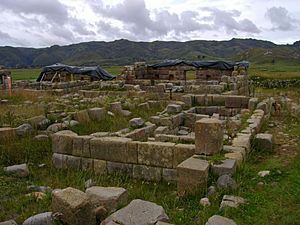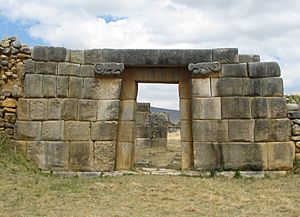Huánuco Pampa facts for kids

Quadrangular walls of the Ushnu.
|
|
| Location | La Unión District, Dos de Mayo Province, Huánuco |
|---|---|
| Region | Andes |
| Coordinates | 9°52′27″S 76°48′57″W / 9.87417°S 76.81583°W |
Huánuco Pampa, also known as Huánuco Marka or Huánuco Viejo, was a very important ancient city in Peru. It is located in the Huánuco Region, high up in the Andes mountains. This large archaeological site sits on a flat area above the Vizcarra River.
The Incas used Huánuco Pampa as a major center to manage their huge empire. It was connected to other parts of the empire by a vast network of roads. The most important road, called the Qhapaq Ñan, ran all the way from Cusco to Quito and passed right through Huánuco Pampa. Inca leaders here controlled at least five different groups of people. The city was built in a strong defensive spot, with deep valleys on all sides. When the Spanish arrived, they briefly took over Huánuco Pampa. However, they soon moved their settlement because of the cold weather and attacks from Inca warriors.
Contents
Exploring the Ancient City
Huánuco Pampa is located about 3,625 meters (11,893 feet) above sea level. It sits on a high plateau, offering great views of the Vizcarra River below.
City Design and Buildings
This Inca center was designed to show the power of the empire. It had a huge rectangular main square, measuring 550 meters by 350 meters. This is bigger than 19 hectares (47 acres)! In the middle of the square, or sometimes to one side, there was a special platform. This platform was called an ushnu. Officials would stand on it to lead important state ceremonies. The main Inca highway, the Qhapaq Ñan, went right through this central square.
The city covered about 2 square kilometers (0.77 square miles). It had more than 4,000 buildings. Pathways spread out from the main square, dividing the city into up to 12 different areas. Experts believe this design might have shown how the different groups of people in the area were connected. Many people who came to Huánuco Pampa did not live there permanently. They visited to do their duties or take part in special events.
Huánuco Pampa was one of at least six places the Incas called "New Cuscos." These cities were built to look like the capital city, Cusco.
The Inca Roads
The Inca road system was incredibly large and well-built. The main north-south highway, the Qhapaq Ñan, stretched from Cusco all the way to Quito, Ecuador. This important road passed directly through Huánuco Pampa. The Qhapaq Ñan and other roads in Huánuco Pampa had paved surfaces. They also featured paved staircases, stone drainage channels, and strong walls. There were even bridges and raised paths called causeways. In some places, the Qhapaq Ñan was 15 meters (49 feet) wide. One paved staircase was 16 meters (52 feet) wide! Sometimes, two roads ran side-by-side.
Special Ceremony Areas
The ceremonial parts of Huánuco Pampa show amazing Inca building skills. They used finely cut and fitted stones in a style called Imperial Inca masonry. The eastern part of the city has the Casa del Inca (House of the Inca). The ushnu, or castillo, is in the main central square.
The Casa del Inca
To enter the Casa del Inca, you would pass through special gates. These gates were made of high-quality Inca masonry. They even had carved figures and pumas on the sides! The walls connecting these gates were built from pirqa. This is a type of masonry using fieldstones set in mud. Large buildings called kallanka were also found here. They were made from good quality pirqa masonry, not cut stones. These big buildings might have been used as barracks for soldiers, counting houses, or for many other purposes.
Inside the Casa del Inca were fifteen different structures. They all opened onto a central courtyard. These buildings served many uses. There were houses, baths made with Inca masonry, and even terraced gardens. There were also pools and possibly a temple. It seems this temple might not have been fully finished before the city was left empty.
The Ushnu Platform
The ushnu is the main platform in the central square. It is a solid platform built with Imperial Inca style masonry. On the lower terrace, there are two smaller buildings. These might have been used for ceremonies performed on the ushnu. The gates of the ushnu have stone sculptures. These sculptures might represent pairs of pumas. The ushnu is found at several other Inca sites. Important leaders likely used it for public events. These events could be political, administrative, or ceremonial.
Inca Art and Pottery
During ceremonies or other big events, Inca artwork was common. Pottery items were often used. Textiles (woven fabrics) and metals were also important to the Inca civilization. But Inca pottery was truly special. The Cusco-style pottery, with its many colors, is a clear sign of Inca presence. Pottery was especially important for ceremonies. It was not usually used for everyday tasks or by local groups.
Places Where People Lived
The northern and southern parts of Huánuco Pampa were mostly residential areas. These were called barrios or quarters. In some places, the houses were arranged very neatly. For example, the cuartel in the northern barrio looked like army barracks to Europeans. Many Inca people lived in rectangular houses. These houses had trapezoid-shaped spaces in their inner walls. All these houses were built using pirqa masonry. This means they had two faces of stone with rubble and mud in between. Many of these houses were built around a central courtyard.
Different groups of people moved in and out of the city often. This was because of ceremonies and duties. So, no one large group called Huánuco Pampa their permanent home. However, archaeological findings suggest that one important group of permanent residents was the Aqllakuna. These were women who served the Inca state and religion.
In 1539, the first Spanish conquerors founded a city at Huánuco Pampa. But because of the very cold climate, they soon moved it. They chose a warmer valley called Pillco, located on the Huallaga River.
The Storage Area
The storage area at Huánuco Pampa was huge! It included 497 qullqas (storehouses). There were also 30 buildings for processing goods and managing the area. This suggests that the city was a very important center for distributing goods. It likely supplied nearby villages with products from other regions.
The qullqas were built in rows, using pirqa masonry, just like the houses. These groups of storehouses had different purposes:
- Some smaller storehouses might have held goods for the Sun, the state religion.
- Other small groups of single storehouses were for special shrines or ceremonies.
- A less clear section of buildings might have held various goods for short-term use.
- The largest group was for long-term storage of different foods and other items. These facilities were specially designed for different types of goods.
For example, root crops were stored in rectangular buildings. They were placed in layers of straw and tied into bundles. Maize (corn) was stored without its husks in large jars. These jars were put in circular storehouses with stone floors. Root crops filled 50-80% of the storage space. Maize took up 5-7%.
The amount of supplies coming into Huánuco Pampa was not always the same. Sometimes, there might have been famines. Or the system for delivering goods might have broken down. The demand for goods also changed constantly. Having large storage areas was vital for keeping a city like Huánuco Pampa running smoothly.
See also
 In Spanish: Huánuco Pampa para niños
In Spanish: Huánuco Pampa para niños




